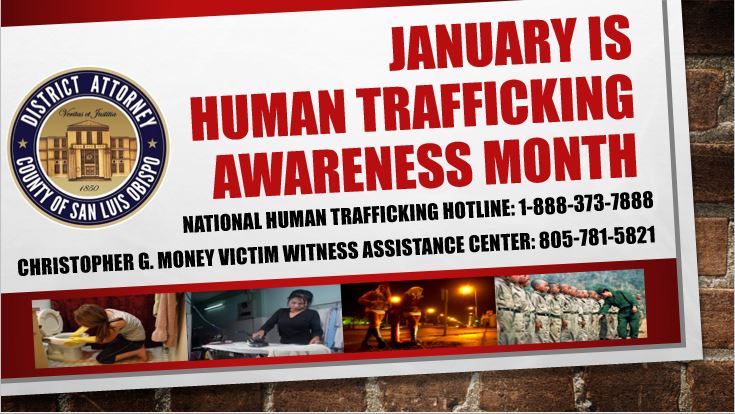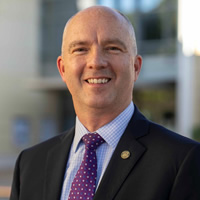
6 Things to Know About Human Trafficking in SLO County
Author: District Attorney's Office
Date: 1/23/2019 3:36 PM
Have you noticed the subject of human trafficking in the news, on television or while scrolling through social media? Trafficking is modern-day slavery and exists in San Luis Obispo County. Here are some important things you need to know about human trafficking.
1. Why are we talking about human trafficking in San Luis Obispo County?
Labor and sex trafficking are happening in San Luis Obispo County. The District Attorney’s Office has prosecuted nine human trafficking cases since 2014. These cases involved 26 victims of commercial sex/labor trafficking, 15 of which were minors. Unfortunately, these numbers do not fully represent the extent of human trafficking occurring on our Central Coast. Some victims fear or are skeptical of law enforcement and will instead reach out to nonprofit or a faith-based organization for help. Many victims may not have the opportunity to seek help or even know where to look for that help.
2. What is Human Trafficking?
Human trafficking is the business of stealing freedom for profit. There are two primary types of human trafficking, sex trafficking and labor trafficking. Sex trafficking occurs when a victim is induced by force, fraud or coercion to perform sex acts for the profit of the trafficker. Labor trafficking occurs when a victim is subjected to involuntary servitude (with little or no pay) by force, fraud or coercion. Victims are lied to, assaulted, threatened or manipulated into working under inhumane, illegal or otherwise unacceptable conditions. Human trafficking is a multi-billion-dollar criminal industry that denies freedom to 24.9 million people around the world. (Polaris Project – polarisproject.org)
3. What are the signs of trafficking?
The person:
- is not free to leave or come and go at will
- Is under 18 and is providing commercial sex acts
- Is in the commercial sex industry and has a pimp / manager
- Is unpaid, paid very little, or paid only through tips
- Works excessively long and / or unusual hours
- Owes a large debt and is unable to pay it off
- Was recruited through false promises concerning the nature and conditions of his / her work
- High security measures exist in the work and / or living locations (e.g. opaque windows, boarded up windows, bars on windows, barbed wire, security cameras, etc.)
- Is living and working on site
- Experiences verbal or physical abuse by their supervisor
- Is not given proper safety equipment
- Is not paid directly
- Is fearful, anxious, depressed, submissive, tense, or nervous / paranoid
- Has few or no personal possessions
- Is not in control of their own money, financial records, or bank account
- Is not in control of their own identification documents (ID or passport)
- Is not allowed or able to speak for themselves (a third party may insist on being present and / or translating)
Trafficking is an enormous issue and can feel overwhelming. We as a community have taken steps to address this hideous crime in our county.
4. What is being done?
In 2014, the San Luis Obispo County Anti-Human Trafficking Task Force formed. The Task Force is a group of approximately 30 government agencies and private organizations working collaboratively to identify trends, effects and resources that are necessary for our fight against human trafficking. The task force includes non-profit organizations; local, regional and national law enforcement agencies; health care providers; faith-based organizations; and community members. The task force members are passionate about identifying, preventing and ending trafficking on the Central Coast. The group has been a great resource for increasing awareness of human trafficking through effective communication between task force partners and by providing education and training within our community. The SLO County Anti-Human Trafficking Task Force has worked collaboratively with community partners to provide support to survivors of human trafficking.
5. What can you as a community member do?
Volunteer or donate to a local nonprofit whose mission is to end trafficking on the Central Coast. Central Coast Freedom Network offers a 40-hour human trafficking training for concerned citizens who want to volunteer. For information go to www.centralcoastfreedomnetwork.org.
If you see something suspicious, report it to law enforcement. Do not investigate yourself. You could endanger the victims or yourself. Law enforcement agencies in San Luis Obispo County are trained to investigate trafficking. If you are unsure about calling law enforcement, you can always call the Polaris Project, a national group working to track and end human trafficking. The Polaris Project website has educational information and national statistics. Polaris will take the report (anonymously, if wanted) and filter it to local law enforcement. To make a report call 1-888-373-788 (24-hour crisis line) or visit www.polarisproject.org.
Most of all, be aware of what is going on around you.
6. Know the signs.
We can look at a list of signs, but how does that translate into our world? Here are several questions to ask yourself.
- When you go to a business, do you notice if the workers are living on site?
- What are the conditions of that living situation?
- Do workers seem fearful?
- Most importantly, what are your instincts telling you?
Important Upcoming Events:
- All are welcome to attend a Candlelight Vigil in honor of the victims and survivors of human trafficking on our community. On January 31, 2019 from 5:30pm until 6:30pm in front of the San Luis Obispo County Courthouse. (1050 Monterey, SLO). The ceremony will include statements from survivors, advocates and local leaders and opportunities for action.
- If you would like an educational presentation on human trafficking, please contact Beth Raub at the Victim Witness Assistance Center. [email protected] or 805-781-5821
